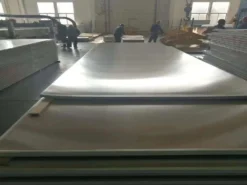Stainless steel is steel with a chromium content of at least 10.5% and a maximum carbon content of no more than 1.2%, as specified in GB/T20878-2007.
The corrosion resistance of stainless steel decreases with the increase of carbon content. Therefore, the carbon content of most stainless steel is low, with a maximum of no more than 1.2%. The ωc (carbon content) of some steels is even lower than 0.03% (such as 00Cr12 ). The main alloying element in stainless steel is Cr (chromium). Only when the Cr content reaches a certain value, the steel has corrosion resistance. Therefore, stainless steel generally has a Cr (chromium) content of at least 10.5%. Stainless steel also contains Ni, Ti, Mn, N, Nb, Mo, Si, Cu and other elements.
Stainless steel is a type of steel that is resistant to weak corrosive media such as air, steam, water, etc.
Main type:
Stainless steel is often divided into martensitic steel, ferritic steel, austenitic steel, austenitic-ferritic (duplex) stainless steel and precipitation hardening stainless steel according to the organizational state. In addition, it can be divided according to its composition: chromium stainless steel, chromium-nickel stainless steel, chromium-manganese-nitrogen stainless steel, etc. There is also special stainless steel for pressure vessels 《GB24511_2009_Stainless steel plates and steel strips for pressure-bearing equipment》
The main characteristics are Weldability, Corrosion Resistance, Polishability, Heat Resistance.
According to the composition, it can be divided into Cr series (400 series), Cr-Ni series (300 series), Cr-Mn-Ni (200 series), heat-resistant chromium alloy steel (500 series) and precipitation hardening series (600 series).
200 Series: Chromium-Manganese-Nickel: SS201, SS202.
300 Series: Chromium-Nickel Austenitic Stainless Steel: SS304, SS301, SS302, SS304L, SS309, SS310, SS316, SS316L, SS321, SS347.
400 Series: Ferritic and martensitic stainless steel, manganese-free, can replace 304 stainless steel to a certain extent. SS408, SS409, SS410, SS416, SS420, SS430, SS440.
500 Series: Heat-resistant chromium alloy steel.
600 Series: Martensitic precipitation hardening stainless steel.
Surface Finishing Grade:
-Original surface: NO.1 The surface subjected to heat treatment and pickling treatment after hot rolling. Generally used for cold rolled materials.
-Blunt surface: NO.2D, which has been heat treated and pickled after cold rolling. The material is soft and the surface is silvery white. It is used for deep stamping processing.
-Matt surface: NO.2B After cold rolling, it is heat treated, pickled, and then finished rolled to make the surface moderately bright.
-Coarse grit NO.3 is a product ground with No. 100-120 grinding belt. Has better gloss and discontinuous rough lines
-HAIRLINE: HLNO.4 is a product with a grinding pattern produced by continuous grinding with a polishing belt of appropriate particle size. It is mainly used for architectural decoration.
-Bright surface: BA is a product obtained by cold rolling, bright annealing and smoothing. The surface has good gloss and high reflectivity, like a mirror.
Theoretical weight calculation of stainless steel products:
1. Stainless steel plate/strip reference formula: stainless steel plate weight (kg) = length (m) * width (m) * thickness (mm) * density ρ (g/cm³).
2. Stainless steel round rod/steel wire reference formula: stainless steel round rod weight (kg)=(diameter (mm)/2)*(diameter (mm)/2)*π*length (m)*density ρ(g/cm³)/1000 .
3. Stainless steel round tube reference formula: weight of stainless steel round tube (kg)=((outer diameter (mm)/2)*(outer diameter (mm)/2)-(inner diameter (mm)/2)*(inner diameter (mm)/ 2))*π*length (m)*density ρ(g/cm³)/1000; **wall thickness (mm)=(outer diameter (mm)-inner diameter (mm))/2.
4. Stainless steel square tube reference formula: stainless steel square tube weight (kg)=(section length (mm)*2-section width (mm)*2-wall thickness (mm)*4)*wall thickness (mm)*length (m) *Density ρ(g/cm³)/1000.
5. Reference formula for stainless steel equilateral angle steel: weight of stainless steel equilateral angle steel (kg)=(section side length (mm)*2-side thickness (mm)*length (m)*density ρ(g/cm³)/1000












